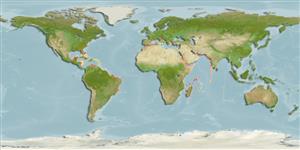Zoothamnium niveum Ehrenberg, 1838
| Native range | All suitable habitat | Point map | Year 2050 |

|
| This map was computer-generated and has not yet been reviewed. |
| Zoothamnium niveum AquaMaps Data sources: GBIF OBIS |
Google image |
No photo available for this species.
Classification / Names Common names | Synonyms | CoL | ITIS | WoRMS
Oligohymenophorea | Sessilida | Zoothamniidae
Environment: milieu / climate zone / depth range / distribution range Ecology
Benthic; brackish. Tropical
Distribution Countries | FAO areas | Ecosystems | Occurrences | Introductions
Central Atlantic, Mediterranean and the Red Sea.
Length at first maturity / Size / Weight / Age
Maturity: Lm ? range ? - ? cm Max length : 1.5 cm TL male/unsexed; (Ref. 87022); common length : 0.5 cm TL male/unsexed; (Ref. 87023)
Life cycle and mating behavior Maturity | Reproduction | Spawning | Eggs | Fecundity | Larvae
Main reference
References | Coordinator | Collaborators
Rinke, C., S. Schmitz-Esser, K. Stoecker, A.D. Nussbaumer, D.A. Molna´r, K. Vanura, M. Wagner, M. Horn, J.A. Ott and M. Bright 2006 Candidatus Thiobios zoothamnicoli, an ectosymbiotic bacterium covering the giant marine ciliate Zoothamnium niveum. Applied and Environmental Biology 27(3):2014-2021. (Ref. 87022)
IUCN Red List Status
(Ref. 130435: Version 2025-1)
CITES status (Ref. 108899)
CMS (Ref. 116361)
Threat to humans
Human uses
| FishSource |
Tools
More information
Diet composition
Food consumption
Predators
Max. ages / sizes
Length-weight rel.
Length-length rel.
Length-frequencies
Mass conversion
Abundance
Internet sources
BHL | BOLD Systems | CISTI | DiscoverLife | FAO(Publication : search) | Fishipedia | GenBank (genome, nucleotide) | GloBI | Gomexsi | Google Books | Google Scholar | Google | PubMed | Tree of Life | Wikipedia (Go, Search) | Zoological Record


